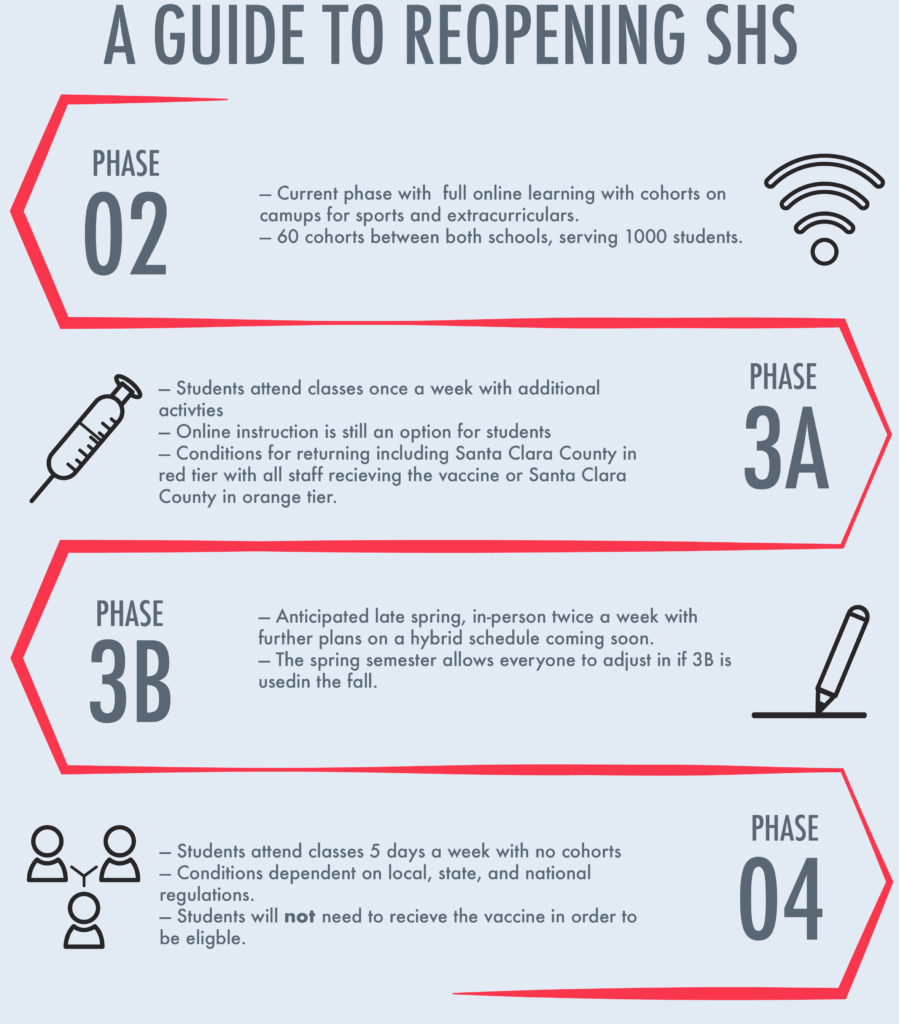In a town hall webinar on Feb. 4, district leaders detailed plans to begin shifting Saratoga and Los Gatos High Schools into Phase 3A of the district’s reopening plan. Currently, the district is in Phase 2B — small volunteer cohorts meeting on campus.
Phase 3A would continue the district’s gradual approach to reopening. Stable cohorts are maintained, just as in Phase 2, and in Phase 3A all students will be able to attend one in-person class on Wednesdays with a cohort. The current academic schedule and class timing will be maintained.
In addition to attending class, students will also have the opportunity to participate in labs, academic tutorials and in-person discussions, allowing students to receive additional academic and emotional support. Phase 3A will also act as a transition period for teachers to adjust their teaching methods; they will practice simulcasting classes while wearing a mask and social distancing in their classrooms.
”Phase 3A allows teachers to make connections with students but also get comfortable with the manner and technology with which we do a hybrid model before we go into a full blown hybrid model,” said Kristofer Orre, a science teacher who also serves as an educational coach.
In order to begin implementing Phase 3A, Santa Clara County must either enter the Orange tier or enter the Red tier and all the staff have the chance to be vaccinated. The tier system is a series of state guidelines classifying counties by test positivity rate and adjusted case rate.
On Feb. 4, Santa Clara County announced that ages 65 and up have been approved to receive the COVID-19 vaccine. State guidelines indicate that after this group, educators are the next priority to be vaccinated.
Human resources director Brian Safine said there is no clear timeline for when teachers will receive the vaccine. Students will not be required to be vaccinated before returning on campus in any of the reopening phases, although this raised some safety concerns among community members.
”We believe there are very real academic and social emotional benefits of returning to school while risks are mitigated when we reach Red and Orange tiers,” superintendent Mike Grove said during the webinar. “It’s a question of risk tolerance and we believe that the benefits of doing so outweigh the risks, particularly because those who aren’t comfortable with the risks will have the option to stay home.”
Currently, the county is in the Purple tier, the most restrictive phase.
As part of Phase 2B, 60 cohorts are operating at Los Gatos and Saratoga High, serving about 1,000 students in total across the district. These cohorts are for various extracurriculars, sports training and a few authorized classes. Phase 3A expands on this by giving all students the chance to return to school for at least one class a week. Returning on campus during any part of the four-phase reopening plan is entirely voluntary for students.
The efforts to ensure student and staff safety are two-pronged: the district has invested into various forms of protective equipment, some of which is provided by the state, and will follow strict screening protocols.
The district has been collecting masks and gloves, installing HVAC air filters for each classroom and placing UVC disinfection units, hand sanitizer stations and sneeze guards in the main office of each high school.
Prior to the Phase 3 return of students, each classroom will have a sign that indicates the maximum occupancy to maintain 6 feet of social distancing. Based on this information, students may end up attending class in a different classroom than normal to ensure proper distancing, though detailed plans on teacher movement have not yet been released.
To minimize face-to-face interactions among students, the district has purchased floor markings that indicate 6 feet of distance and which direction a student should walk around campus. Strict screening protocols will also continue to be enforced in Phase 3A. All students and staff who go on-campus in a cohort must complete daily screening forms which ask about possible exposure in their immediate family and whether they left the county in the last 14 days. Students will also be required to wear face coverings at all times and maintain social distancing.
“When we look at a reopening plan and how we can support students and staff, health and safety is our number one concern,” said facilities director Tony Palma.
One difference between Phase 2 and Phase 3A is the degree of testing. Currently, on-campus staff members have the chance to be tested twice a month, while students are not tested at all. Safine said that the district is working with Curative and other vendors to secure testing for students. Testing for students will be optional, although it is highly recommended.
For now, the timeline for implementing Phase 3A remains unclear. Associate superintendent Carrie Bosco said the district is still hopeful for a transition all the way into Phase 3B this spring. Phase 3B will be a hybrid model of learning where students would return to campus two days per week for classes as normal and will not be in cohorts. Given the unpredictability of the pandemic, details are still being worked out.
Nevertheless, some classes will not be able to restart even during Phase 3A. Music and choir will not be permitted to conduct in-person classes and rehearsals due to an increased possibility of aerosol transmission, district leaders said.
“We’re learning as we go.” Grove said. “This is one of those situations where regardless of what we as a district choose to do, some portion of our community and staff will be unhappy with our decisions. But I hope we can all remember that we share the same goal: to do what is best for our students and staff.”
The Feb. 4 video of the community town hall is available online.


























